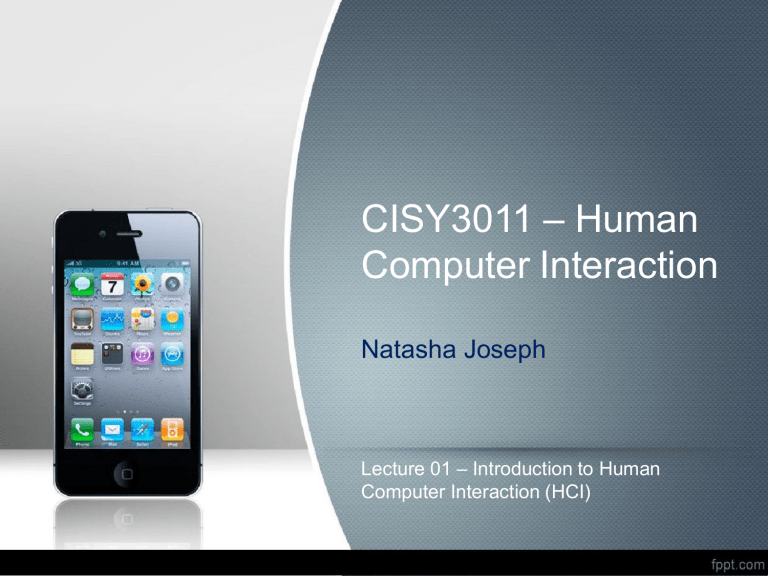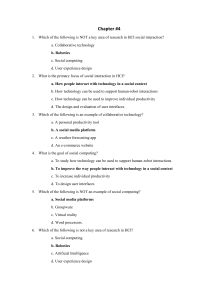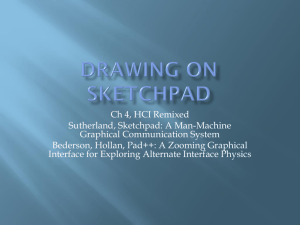
CISY3011 – Human Computer Interaction Natasha Joseph Lecture 01 – Introduction to Human Computer Interaction (HCI) What is it About? • Humans – Working – Routines-Workflows – Capabilities ~ Limitations • Machines – Used – Mode of Operation – Possibilities ~ Limitations • Interface – Man-Machine Interaction – Human-Computer Interaction – Embedded Systems What is it About? • It is about system development Nearly half of entire software development effort relates to the user interface. (Myers and Rosson, 1992) Human Computer Interaction • As a Science – – – – Methods Formalisms Relations and Overlap disciplines Measurement • As a Product (Interactive Software Products) – Design – Technology – Measurement Human Computer Interaction • Interface – Present instructions to human – Translate instruction from human to machine • Interaction – Offer mode of operation – Connect with interface – Complete a task Early Human Computer Interaction Computing in 1945 Harvard Mark I ASCC: IBM Automatic Sequence Controlled Calculator (aka Mark 1) The Old Interactions • • • • • • Mechanical Poor feedback Specialist use Process control Calculations No intention to address the mass market What is HCI? • Early computers: extremely difficult to use – large & expensive – used by specialists – no knowledge about how to make use easier • Current – None of these conditions hold – Development of PC’s major landmark • Shift to other interaction paradigms – Small & Handheld - Devices – Robots Interaction Paradigms Initial Outlook of Human Interaction • Wide acceptance of computers (as of 1980s) • Consequences: – Computers must be well-designed – Interactions must be well-designed • Users should not have to think about its use – Intuitive – Logical responses – Safe • Two crucial concepts – Design – Interaction Interactions with Small Devices Compared to Mark I… Interaction With Computers • Responses are – Logical – In context – Emotive Directions in HCI bot-interaction • Human Robot Interaction – https://www.youtube.com/watch?v=Stzdxu cJDGA • Whole new range of interactions Machine Personal Relations • Robots get more human – Android – Geminoid – Ubiquitous phenomena Android • Interaction will be more human – Emotive response – Personal relations Geminoid Design: Interdisciplinary Field • HCI combines knowledge and methods associated with professionals including: – Computer Scientists – Psychologists • Experimental, Educational, Social and Industrial – Designers • Instructional and Graphical – Technical Writers – Human Factors and Ergonomics Experts – Anthropologists and Sociologists Disciplines contributing to HCI User Interface Design User Experience ( UX) Interaction Design (IxD) Human Computer Interaction (HCI) Development of HCI • 1970s: notion of User-Interface arises • Also known as Man-Machine Interface – “those aspects of the system that the user comes in contact with” [Moran, 1981] – “input language for user, an output language for machine and a protocol for interaction” [Chi,1985] Early concepts in HCI • Companies started to call their products: – “user-friendly” • In practice: – Just tidy up the screens – Make them more aesthetically pleasing – No design decisions nor interaction plan • Meanwhile: – Research focus on capabilities/limitations of people – Important focus on psychological factors – Focus on aspects of ergonomics User Friendly • What is User Friendly? • Can we measure it? • Criteria adhering to some standard? • Prototyping, Prototyping styles • Usability, Usability criteria • Evaluations, Evaluation techniques • All are based in getting the User involved! Definitions of HCI • A workable definition is: “a set of processes, dialogues and actions through which a human employs and interacts with a computer” • A focus on the research themes: “a discipline concerned with the design, evaluation, and implementation of interactive computing systems for human use and with the study of major phenomena surrounding them” Breaking down HCI definition • Human – Users single, group working together, sequence – User(s) tries to complete a task. • Computer – Technology not just Desktop computer – Systems: • Large-scale computers • Process control • Embedded systems • Interaction – Communication, direct/indirect – Dialogue + feedback – Task oriented Development Attitude • Computing paradigms have shifted – Early computing had no end users. – “end users” are extremely important – Natural focus is on the needs capabilities of these end users – Interface design – Interaction design and “Nearly half of entire software development effort relates to the user interface.” [Myers and Rosson, 1992] Design • Design is where you stand with a foot in two worlds : – the world of technology and – the world of people and human purposes The purpose of design is trying to bring the two together. Design and Interactive Systems • Examples – Mobile phones: • transmit, store and transform information – Websites: • store and display information and respond to people’s actions – Computer game controllers • dynamic response to actions – Interactive installations • transmit information, generate dynamic response People and Technologies • People and interactive systems are different: – this entails the fundamental challenge for interactive systems designers is to deal with. Interface • The interface to an interactive system is all those parts of the system with which people come into contact with; physically, perceptually and conceptually. • Physically – Pressing buttons, moving levers – Interactive device might respond by providing feedback • Perceptually – Display things on a screen which we can see – Make noises which we can hear. Interface • Conceptually – Trying to work out what it does – What we should be doing – Messages/Indicators designed to help us do this • The interface consists of – Input – Output – HCI needs a (conceptual) model for this Visualization • Visualize: – To form a mental model or mental image of something – To make something visible to the mind or imagination • New concepts – Mental model, Mental image – Abstractions A disaster story – HCI & InfoViz related • 1988 : – Iran Air Flight 655 shot down by USS Vincennes – F-14?? - 290 casualties – Conclusion: ‘Aegis had provided accurate data. The crew had misinterpreted it.’ – Different radar screens displayed different aspects of airplane – Correlating information was difficult – Vital data cluttered by trivial data A disaster story • What about Boeing 737 MAX? – Where did it go wrong? Insightful Video - https://youtu.be/UbhztWxcreA


